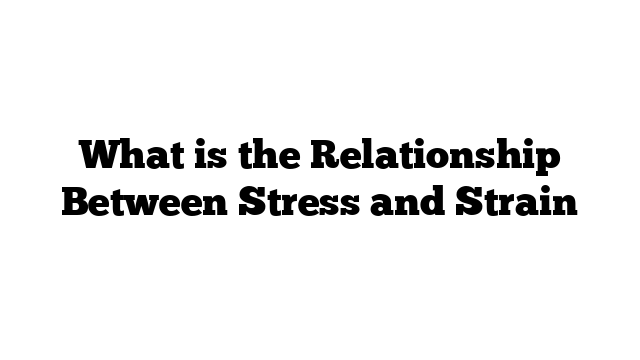Introduction:
Stress and strain are fundamental concepts in physics that help describe the behavior of materials under external forces. The relationship between stress and strain is vital in understanding how materials deform and respond to applied loads. In this article, we will explore the concept of stress and strain, their definitions, and the relationship between them.
I. Definitions:
A. Stress:
Stress is defined as the force per unit area acting on an object. It represents the internal resistance of a material to external forces. Stress is typically measured in units of pressure, such as pascals (Pa) or newtons per square meter (N/m²).
B. Strain:
Strain refers to the amount of relative deformation caused by an applied force on an object. It is a measure of how much an object changes shape or size due to stress. Strain does not have any units since it is a ratio of change in length or dimension to the original length or dimension.
II. Hooke’s Law:
Hooke’s Law explains the relationship between stress and strain for materials within their elastic limit. According to this law, the strain in a solid is directly proportional to the applied stress, as long as the material remains within its elastic limit. This relationship can be expressed mathematically as:
σ = Eε
Where:
– σ represents stress
– E is the modulus of elasticity (Young’s modulus)
– ε denotes strain
III. Stress-Strain Curve:
The stress-strain curve is a graphical representation of the relationship between stress and strain for a specific material. It provides valuable insights into a material’s mechanical properties and behavior under different loading conditions. The curve is obtained by plotting stress against strain values during a controlled test.
A typical stress-strain curve consists of several regions:
A. Elastic Region:
In the elastic region, stress and strain are directly proportional to each other, following Hooke’s Law. The material behaves elastically and returns to its original shape once the load is removed.
B. Yield Point:
The yield point marks the transition from elastic to plastic deformation. Beyond this point, the material starts to undergo permanent deformation.
C. Plastic Region:
In the plastic region, the material deforms significantly without any increase in stress. It undergoes permanent changes in shape or size even after the applied load is removed.
D. Ultimate Tensile Strength:
The ultimate tensile strength represents the maximum stress a material can withstand before it fractures or breaks.
E. Fracture Point:
The fracture point is reached when the material fails completely under stress, resulting in a sudden drop in load-carrying capacity.
IV. Applications:
Understanding the relationship between stress and strain is crucial in various fields, including engineering, materials science, and structural analysis. It helps engineers design structures that can withstand expected loads without failure or excessive deformations. By analyzing stress-strain curves, engineers can determine a material’s mechanical properties, such as its strength, stiffness, and ductility.
V. Conclusion:
In conclusion, stress and strain are interconnected concepts that describe the behavior of materials under external forces. The relationship between stress and strain is primarily governed by Hooke’s Law within the elastic limit. By studying stress-strain curves, we can gain valuable insights into a material’s response to different loading conditions. This knowledge is instrumental in designing safe and efficient structures for various applications.
